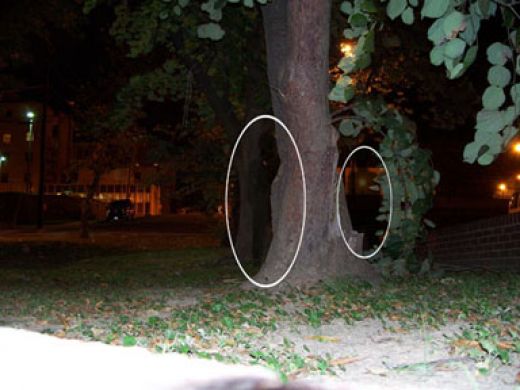 Submitted by Morgana on
Submitted by Morgana on


By Rosemary Ellen Guiley
Copyright Visionary Living, Inc. 2007
Flitting dark forms in haunted locations. Tall sinister figures that stand by the bed at night and watch us. Black silhouettes that peek around doorways and wall corners. They’re all called Shadow People. Our usual gut reaction to them: Fear. Panic. Terror.
Are they dark ghosts of human beings, or some other entities? Whoever they are, why do they seem so intensely interested in us?
My curiosity about Shadow People led me to start a research project to learn more about them by soliciting personal experiences and researching them against folklore, paranormal literature, mythology, and so forth. I thought I’d probably collect a few dozen stories and write an article or two.
More than two years on, I’m still collecting – more than 400 stories so far – and I’m more intrigued than ever. Shadow People are a complex phenomenon, and researching them raises more questions than reveals answers. One of the more interesting angles is that some Shadow People may have nothing to do with ghosts, but may be are part of an alien monitoring program. Who are behind the Shadow People, and what is their agenda? Here is a summary of my findings so far.
Characteristics
There are different types of Shadow People. The core, dominant experience is the nighttime bedroom visitor: a tall silhouette of a man, often dressed in a coat or cape, and a brimmed hat. The figure is blacker than black and 3-D, obstructing light and blocking the view of objects. There are no facial features or eyes (sometimes red eyes are reported), but the experiencer knows he is being observed with great intensity. The figures do not communicate, but often radiate a malevolent, trickster, or evil intent.
In the typical experience, a person wakes up from sleep and sees a Shadow Person in the bedroom. It stands right at the bedside, in a corner or in the doorway. It may emerge from a closet or slide out from under the bed. Some of them come through the walls.
The experiencer is usually terrified and screams. A reaction often makes the Shadow Person disappear, either by vanishing into thin air, zipping down a hallway, or melting through a wall or ceiling (or back under the bed!). People may feel paralyzed to do anything but shut their eyes, hoping that the figure will be gone when they open them. Sometimes it is – and sometimes it isn’t.
Some people feel threatened by the Shadow Person. It sits on the bed, or presses on them, making them feel as though they will suffocate or choke. The experience ends before actual physical harm occurs, however.
Other kinds of Shadow People start as shadows on the wall. It takes a moment for a person to realize that the shadow is unnatural and should not be there – and then the shadow starts to move. It materializes from the wall into physical space.
Shadow People also have been reported in wooded areas. In America, accounts of them go back to old Indian lore. They always seem to be watching… for something.
Another category of Shadow People are dark figures seen in some haunted places. Waverly Hills Sanatorium in Louisville, Kentucky, and Eastern State Penitentiary in Philadelphia are famous for them. These figures are believed to be dark ghosts or thought-forms that are part of the haunting phenomena present on site.
Looking for patterns
My call for Shadow People experiences is open-ended: a few questions about the circumstances surrounding people’s experiences. I’m not attempting a scientific statistical study. Rather, I am looking for patterns that might illuminate the how and why of Shadow People.
I found that men and women experience them fairly equally, and that experiences range from childhood on through adult life. Some people have one or two experiences they never forget, and others are “serial experiencers.” There are solo witnesses, multiple witnesses, and family omen-type Shadow People that follow generations. Sometimes Shadow People seem attached to a place, and sometimes they seem attached to individuals or even families, following them wherever they go. Sometimes Shadow People are bad omens, almost like banshees. The appearance of the Shadow Person forecasts a run of bad luck. Other Shadow People experiences seemed linked to states of emotional turmoil.
Possible explanations
Like many paranormal phenomena, Shadow People do not fall into a single neat category. They share characteristics of different types of phenomena or entities. Here are some of the explanations I have examined:
Ghosts: Many haunted places have dark ghosts. Their dark appearances may be due to their ability to manifest – they may be low on our threshhold of awareness – or they may embody a psychic essence of turmoil or violence. At Waverly and Eastern State, for example, we find histories of trauma. At Waverly, thousands died of tuberculosis, and Eastern State housed some violent criminals.
Thought-forms: Shadow People may be coalesced emotions, either residuals that have collected in a place over time, imprinted into the psychic space, or projections from the living. Some of my respondents have volunteered that they think their own dark emotional states have caused or influenced their experiences.
Astral entities or demons: The malevolence radiated by most Shadow People have led many experiencers to interpret them as demonic or low-level astral beings. Such entities might take on a shape-shifted form in order to create havoc.
Nightmare hags: The dark forms, bedside appearances, paralysis and suffocating feelings are characteristic of the “nightmare hag.” In folklore, such entities cause nightmares by sitting on the chests of people while they sleep. Nightmare hags are threatening. Their manifestation is sometimes accompanied by sounds and bad smells, and the appearance of dark forms with red eyes. Shadow People have been described as blobby masses as well as sharply outlined human shapes.
Vampires: In folklore, the vampire is a restless ghost or an entity that sucks off the life force, usually while victims sleep. There is a small overlap here with Shadow People, as experiencers often feel drained – perhaps by the sheer fright of the experience.
Ultraterrestrials: Shadow People may be creatures or beings from other dimensions that layer ours, an explanation proposed for mysterious creatures such as Mothman and Bigfoot. If so, are they just curious about us – or do they have a purpose for visiting us? And why just usually when we sleep?
An ET connection?
An unexpected turn in my data collection shows a connection between Shadow People and ET’s. Shadow People bear a strong resemblance to Men in Black: odd men, dressed all in black suits and black hats, who visit ET/UFO experiencers and warn them not to talk to others. Some ufologists think that MIB are related to government monitoring, but their weird appearance and robot-like ways – as well as their ability to appear and disappear without explanation – point more likely in a paranormal direction.
ET’s who are abductors – the little grays with big black eyes – are bedroom visitors, coming while people sleep. They sometimes come through walls or materialize, and they cause paralyzing fright and terror.
My speculation is that some Shadow People are monitors for ET’s. They may be artificial intelligence or drones programmed to monitor our thoughts and consciousness. It may be easiest for them to do this while we are asleep, which is why they appear as nighttime visitors. They may be programmed to disappear when they are observed. The abducting ET’s monitor people physically. The consciousness monitoring may be another aspect of a bigger program.
- 3813 reads